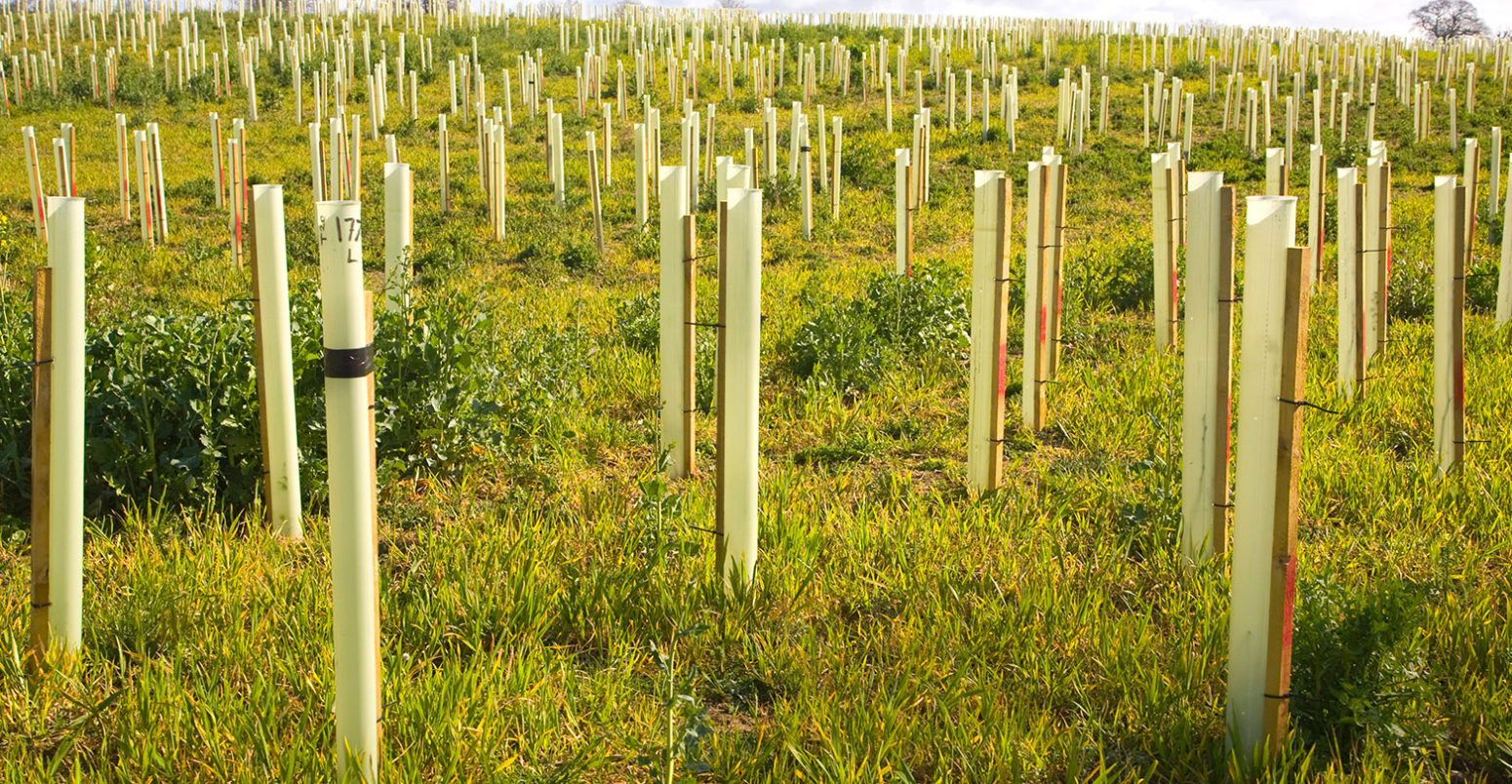
Guest post: Seven key things to know about ‘negative emissions’
Multiple Authors
06.01.18Multiple Authors
01.06.2018 | 12:10pmProf Jan Minx is head of the applied sustainability science working group at the Mercator Research Institute on Global Commons and Climate Change (MCC) and Priestley Chair of climate change and public policy at the University of Leeds; Dr Sabine Fuss is head of the sustainable resource management and global change working group at the MCC; and Prof Gregory Nemet is associate professor of public affairs and environmental studies at the University of Wisconsin at Madison.
Despite the ambitious long-term climate goals of the Paris Agreement, there remains a distinct lack of success at ushering in immediate and sustained reductions in global CO2 emissions.
This cognitive dissonance has seen the topic of “negative emissions” – also known as “carbon dioxide removal” (CDR) – move into the limelight in climate science and policy discussions.
Increasingly, the only way to bridge the growing gap between short and long-term climate policy ambition appears to be developing the ability to remove billions of tonnes of CO2 from the atmosphere and store it on land, underground, or in the oceans.
Yet, the current knowledge on negative emissions technologies (NETs) is diffuse and incomplete. This makes it hard for assessment bodies, such as the Intergovernmental Panel on Climate Change (IPCC), to evaluate the state of knowledge.
In a three-part literature review, published in Environmental Research Letters, we did some of the leg work and systematically assessed what we know and do not know about NETs. We presented our findings at last week’s international conference on negative emissions.
Here are seven central insights from our three papers.
1. CDR should not be framed as geoengineering
NETs are fundamentally different from solar radiation management (SRM), the other set of technologies typically considered “geoengineering”.
While NETs address the root cause of climate change by reducing atmospheric CO2 concentrations in the atmosphere, SRM approaches do not. Instead, they aim to reduce some of the worst impacts of climate change temporarily by reflecting incoming solar radiation.

Schematic illustrating the causal chain of climate change (upper panel) and response options (lower panel). Response options can be divided into mitigation of anthropogenic emissions and direct removal of CO2, which would reduce the heat trapping greenhouse gases, modification of solar radiation, which directly interferes with Earth system reflectivity, and adaptation to climate impacts. Source: Minx et al. (2018)
Other important differences include the novel global risks associated with SRM, the different time scales at which NETs and SRM operate, and distinct governance challenges.
It is more appropriate to consider the way human society responds to climate change in four ways: mitigation, adaptation, CDR and SRM, as laid out in the schematic above. The last two need to be strictly distinguished from each other and not combined together under the label “geoengineering”.
2. The literature on NETs is growing rapidly and diversifying
Overall, the core literature on NETs covers more than 2,000 studies, but is growing exponentially. You can see this in the upper chart below, which shows the accelerating body of work on NETs and the mix of literature on different technologies.
In line with the broad definition of “mitigation” by the IPCC, research initially focused mainly on enhancing natural sinks – such as afforestation and reforestation, soil carbon sequestration, as well as ocean fertilisation.
Explicit discussions about NETs only started during the fourth assessment cycle of the IPCC, from 2001 to 2007, with the emergence of literature on NETs driven by the integrated assessment modelling community. In the fifth assessment report, completed in 2014, NETs were discussed individually and we now have a distinct body of literature for each NET. The lower chart below shows how the literature on NETs in the IPCC reports has diversified with time.
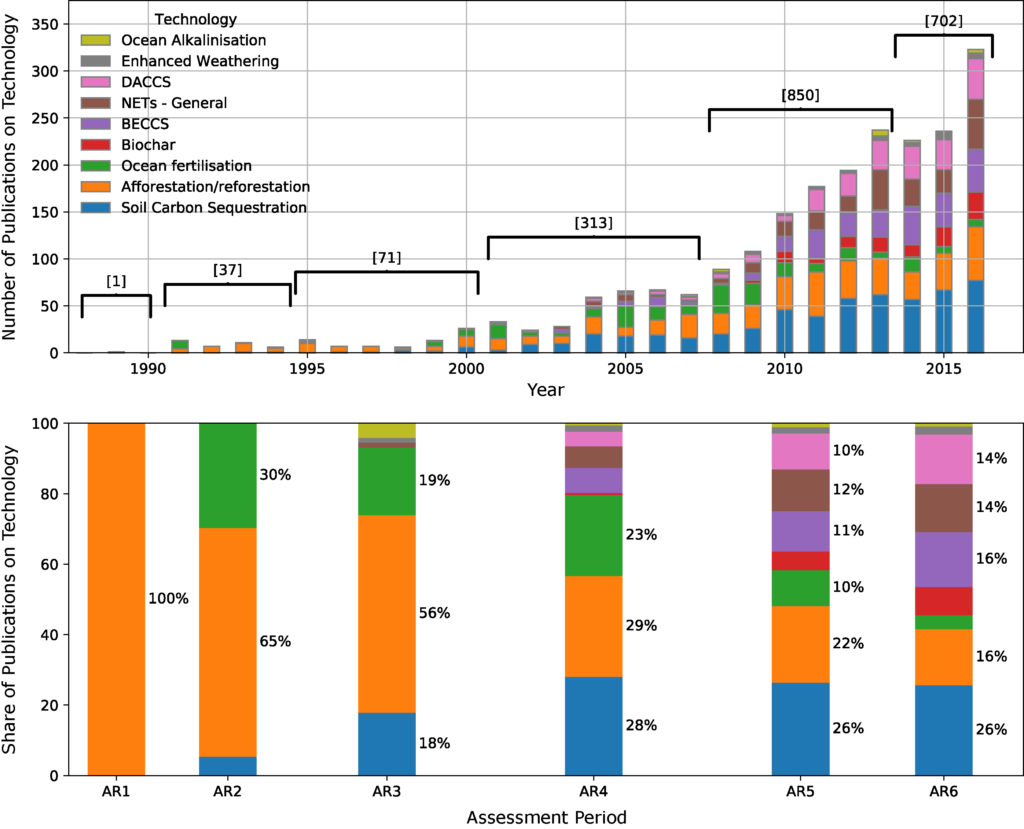
Bar charts display the coverage of NETs in the different assessment cycles of the IPCC. Over time more and more NETs are treated both in the literature as well as in IPCC assessments. Source: Minx et al. (2018)
3. Modelling scenarios depend on negative emissions for 1.5C goal, but not for 2C
Of all the different decarbonisation scenarios considered in our review that succeed in keeping global warming to no more than 1.5C above pre-industrial levels, not one achieves the goal without some form of NETs. Total deployment until 2100 is associated with a cumulative removal from 150 gigatonnes of CO2 (Gt CO2) to be beyond 1,000.
There are some recent scenarios that limit the deployment of NETs to the range of 150-200Gt CO2 over the course of the 21st century. For example, a study published earlier this year showed that NETs can only be avoided theoretically for carbon budgets of 600Gt CO2 and larger.
Yet, such a low deployment can only be achieved in these models at the expense of radical assumptions regarding the timing and pace of global decarbonisation. This does not reflect the current status of international climate diplomacy and existing national commitments to cutting emissions, known as “nationally determined contributions” (NDCs).
The figure below shows that with a larger carbon budget for 2C, the deployment on NETs can still be avoided while meeting this goal, but the door is closing rapidly. It shows how many models can meet the 2C and 1.5C limits with varying amounts of bioenergy with carbon capture and storage (BECCS). For example, no models can meet the 1.5C limit (right-hand section of figure) if there are any constraints on the use of BECCS.
Unless NDCs are made substantially more stringent, the pathways to 2C by 2030 will be similar to current pathways for 1.5C in that they will depend on very large deployments of NETs.
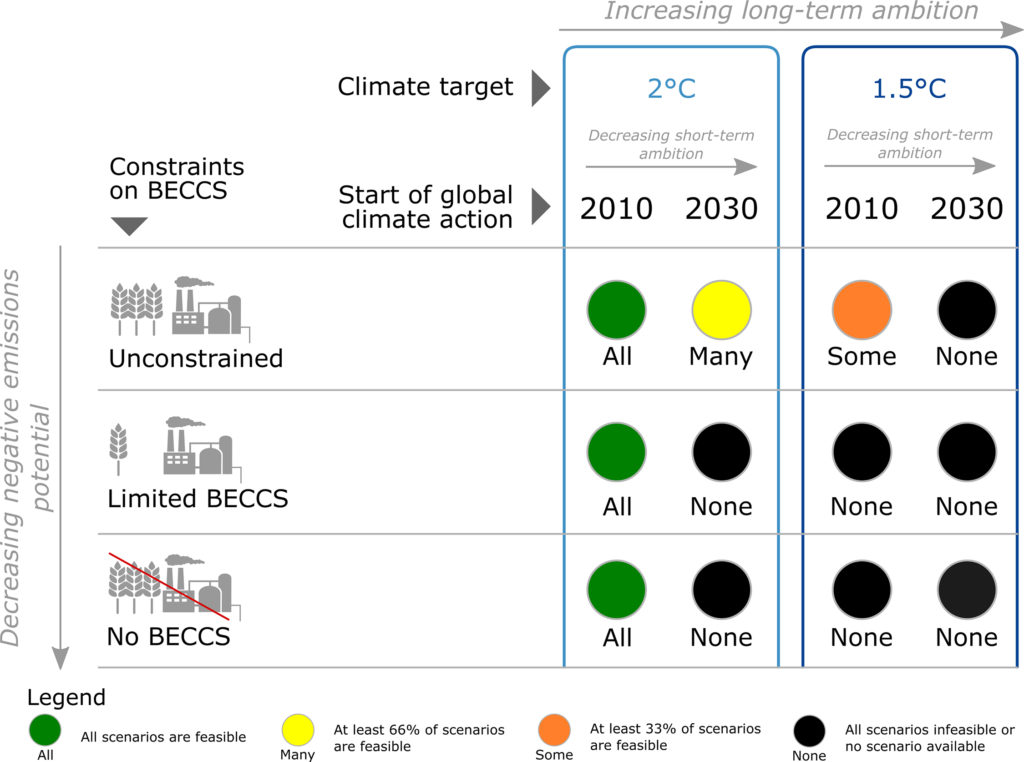
Model feasibility for different climate targets with immediate or delayed start of global climate action and different degrees of constraining BECCS. Source: Fuss et al. (2018). (Note: based on REMIND model runs by Luderer et al (2013)).
4. How society develops is crucial for the amount of NETs needed
The extent of the challenge to mitigate emissions and adapt to climate change is determined, to a large degree, by socioeconomic conditions in the future.
Yet, how such variations affect the prospects for meeting climate goals has been explored systematically only very recently through comparisons of the “shared socioeconomic pathways” (SSPs) – a set of alternative futures that examine how global society, demographics and economics might change over the next century.
The figure below shows that the prevailing conditions have a major effect on NETs dependence. For example, we see much less NETs deployment in scenarios that unfold along a sustainability narrative (SSP1 – shaded green) – with higher levels of education and urbanisation, lower population levels and less inequality within and between countries.
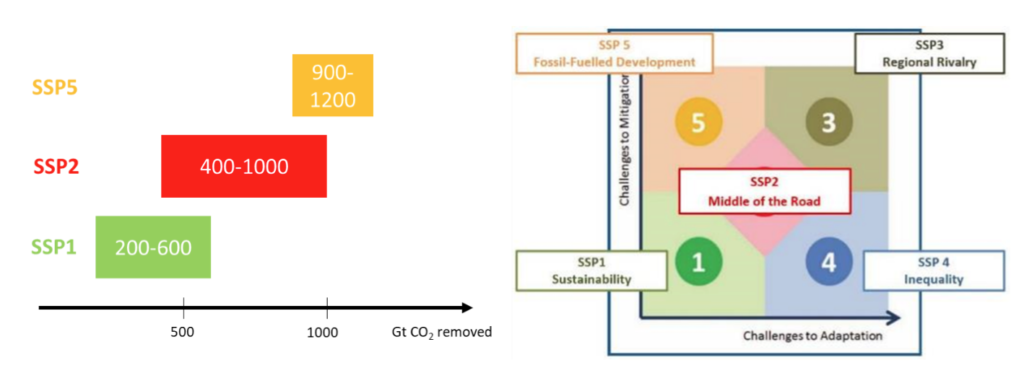
Left panel shows the amount of CO2 removed in different Shared Socio-Economic Pathways (SSPs). Right panel gives an overview of the SSPs and where they are located along the dimensions of challenges to mitigation and adaptation. Data in the left panel is taken from Rogelj et al. (2018)
There is an important implication. We rightly think a lot about how climate policies can reduce emissions within a given socioeconomic pathway. But future social and economic conditions are not set in stone.
We therefore need to think much more about how we can transition between alternative future worlds, for example, from a fossil-fuel intensive world (e.g. “SSP5”) towards one characterised by sustainable development (e.g. “SSP1”). The required non-climate policies to develop sustainably would greatly ease the burden on mitigation and, crucially, would limit dependence on large-scale use of NETs.
5. Most NETs show potential for large-scale deployment, but all have limits
In principle, NETs are feasible at a range of costs and with at least partially proven technology, but not at unlimited scale and not quickly. Many NETs also have high uncertainties regarding their wider impacts.
However, to ascertain the total potential of all NETs, it is not as simple as adding them together. Some NETs compete with one another – for land, water, bioenergy or safe geological storage, for example.
The graphic below summarises the maturity, potential, cost, side-effects and permanence of seven different NETs. The central panel shows how much CO2 each NET could potentially remove from the atmosphere (x axis) and at what cost (y axis).
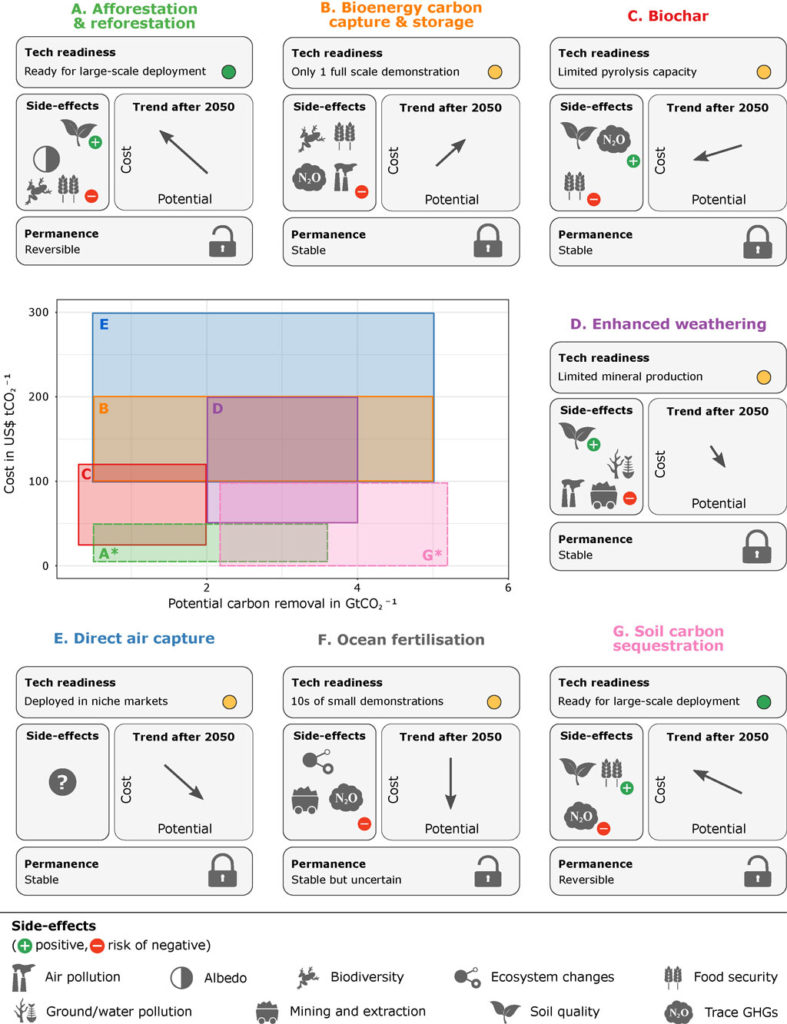
NETs and their major features including costs, deployment potentials, side-effects, permanence of storage as well as development status. Deployment potentials in the central panel are not additive. List of side-effects is not exhaustive. Source: Minx et al. (2018)
In addition, realising the potential of each NET will require reliable institutions that incentivise good governance and practice across the globe.
This may constrain the ability to reach the higher end of deployment ranges – particularly for afforestation and soil carbon sequestration, where the cheapest options and largest potentials are often especially prominent in regions with weak institutions.
At the more expensive end, BECCS and direct air carbon capture and storage (DACCS) may have larger overall potentials and provide more reliable long-term storage, but show substantially higher costs and are currently in an earlier stage of the innovation process.
Our review also suggests that it would be difficult – and unwise – to try to meet the need to remove CO2 with one NET alone. It is, therefore, prudent to think about a NETs “portfolio”, with each deployed at more modest scales and, consequently, with more manageable risks.
In fact, there may be a “natural order“ of NETs deployment that arises from considerations of costs, potentials, effectiveness, availability as well as safe and permanent storage.
For example, an initial phase-in could use some of the land-based options, such as afforestation or soil carbon sequestration, which are readily available, comparatively cheap, and more easily reversible, but suffer from saturation in the long-run and are harder to manage on a large scale. Technological options, such as BECCS and DACCS, could be phased in later and provide the required additional potentials once they are ready.
6. Adverse side effects of BECCS relate specifically to bioenergy
BECCS has come under scrutiny for its need for large land areas on which the biomass would be cultivated. There is concern that it could interfere with food security or safeguarding terrestrial ecosystems. But are these concerns really related to BECCS?
To answer this question, we need to compare bioenergy uptake in model scenarios with and without BECCS.
The chart below shows what this reveals: that overall bioenergy deployment is as high with BECCS (blue line and shading) as it is without (red line and shading). In some non-BECCS scenarios, bioenergy upscaling is even more rapid. This is because bioenergy is a versatile technology that has applications across a whole range of sectoral mitigation options.
In the scenarios without BECCS, bioenergy is applied in difficult-to-decarbonise sectors, such as transport, which otherwise could be compensated for via negative emissions.
Hence, limiting BECCS deployment may not be effective in terms of securing sustainable levels of bioenergy use. Instead, once sustainable bioenergy policies are in place, the particular bioenergy pathways are less of a concern including BECCS.
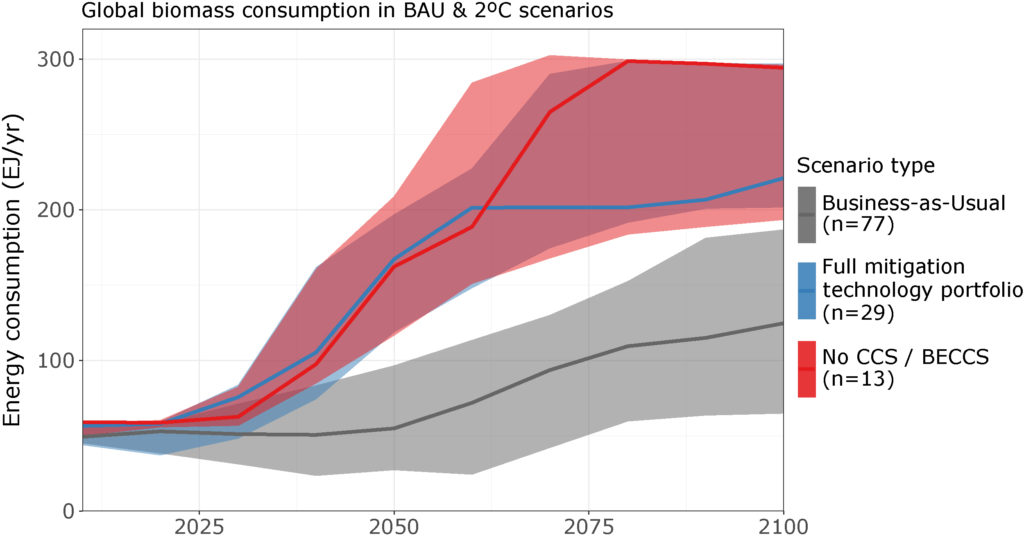
Figure shows baseline scenarios (grey), scenarios with all mitigation options including BECCS (blue) and scenarios excluding BECCS (red), which have higher biomass consumption than the blue and grey ones. Source: Minx et al. (2018)
7. A big gap exists between R&D of NETs and actual deployment
While we are seeing a burst of new literature on NETs, the overwhelming majority focuses on early-stage research. But bringing new technologies to widespread adoption typically requires a sequence of activities beyond research and development, including demonstration projects and serving niche markets, followed by a gradual process of scaling up to a larger market.
Along the way, new technologies face an array of issues, including convincing sceptical “early adopters” and challenges in public acceptance. There is little NETs literature on these later stages and the entire process has typically taken decades to play out for other technologies.
Compared with other low-carbon technologies, for example, it is clear that NETs still have the bulk of their development pathways in front of them.
The graphic below shows solar photovoltaics (PV) as an analogue. The first commercial application was in 1957 and it took 60 years to get to low cost PV. Yet, we are still a couple of decades away from widespread adoption – say 10-30% – of the global energy supply.
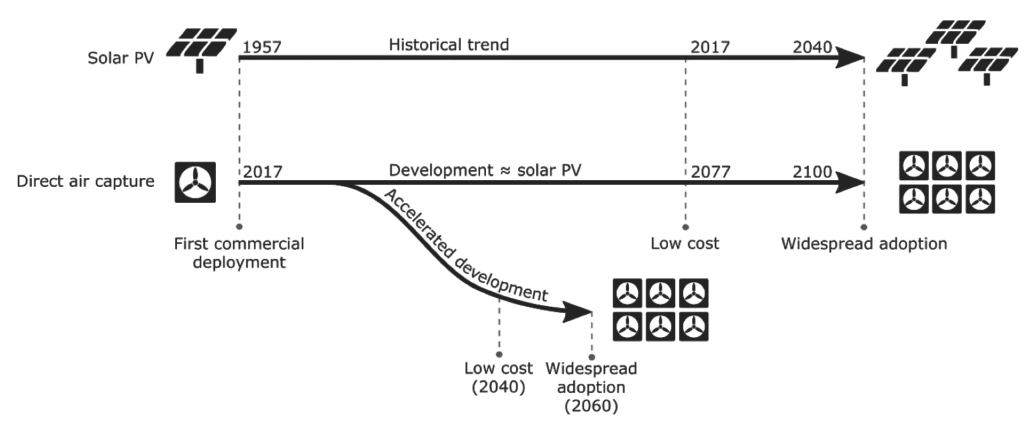
Schematic illustrating the analogue of solar PV upscaling applied to Direct Air Carbon Capture, revealing a huge time gap in deployment for 1.5C relevance. Figure by William Lamb based on Nemet et al. (2018)
Applying this timeline to DACCS would suggest that we will not provide the technology at scale in time to be relevant for climate change. We, therefore, need to think more actively about speeding up innovation for NETs.
A prerequisite is, thus, a more open discussion of accelerating innovation in NETs – both in the literature and in climate policy debates.
Minx, J. C. et al. (2018) Negative emissions – Part 1: Research landscape, ethics and synthesis, Environmental Research Letters, doi:10.1088/1748-9326/aabf9b
Fuss, S. et al. (2018) Negative emissions – Part 2: Costs, potentials and side effects, Environmental Research Letters, doi:10.1088/1748-9326/aabf9f
Nemet, G. F. et al. (2018) Negative emissions – Part 3: Innovation and upscaling, Environmental Research Letters, doi:10.1088/1748-9326/aabff4
-
Guest post: Seven key things to know about ‘negative emissions’
-
The key findings from a major new review of ‘negative emissions’

